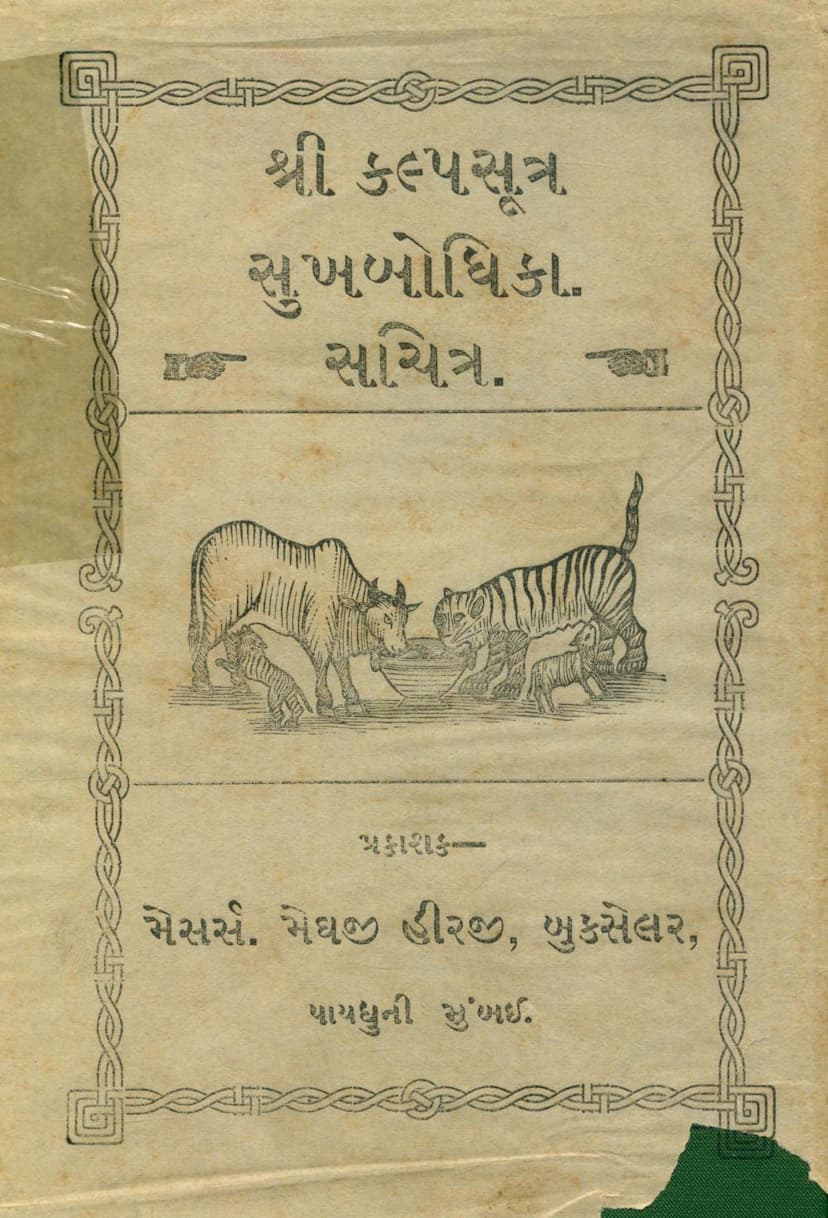Kalpsutra Sukhbodhika Sachitra
Added to library: September 2, 2025

Summary
This Jain text, "Kalpsutra Sukhbodhika Sachitra" by Sushil, published by Meghji Hirji Jain Bookseller, is an illustrated commentary and explanation of the Kalpasutra, a foundational Jain scripture. The work aims to make the original text, which is often dense with Sanskrit vocabulary and archaic language, more accessible to a wider audience.
Here's a breakdown of the key aspects of the text based on the provided pages:
Core Purpose and Target Audience:
- The text explicitly states its intention to make the Kalpasutra "simple and easy" for people to understand, acknowledging that existing translations often fail due to their complex Sanskrit and archaic style.
- The editor, Sushil, emphasizes a careful approach to translation, ensuring that the original meaning of the text is not violated.
- The inclusion of 22 illustrations is a significant feature, indicating a focus on visual learning and making the stories within the Kalpasutra more engaging.
- The work is dedicated to those who wish to "cross and help others cross the ocean of worldly existence" by imbibing the teachings and lives of Mahavir Swami.
Content and Structure:
- Kalpasutra Commentary: The primary focus is on providing a commentary, referred to as "Sukhbodhika," which implies making the text easy to comprehend.
- Illustrations: The book is "Sachitra" (illustrated), featuring 22 pictures, some of which are described as "golden and colorful." The illustrations depict various life events and stories related to Jain Tirthankaras and significant figures.
- Author/Editor: While the Kalpasutra itself is attributed to Bhadrabahu Swami, this specific version's commentary is attributed to Upadhyayji Shri Vinayvijayji Maharaj, and the edition is edited by Sushil.
- Foreword: Dr. Hermann Jacobi, a notable Indologist, has contributed a foreword. The text acknowledges that Jacobi's views have evolved over time but retains his scholarly preface for its insights into Jainism's historical context.
- Structure: The text includes a "Table of Contents" (Chini Suchi) listing the 22 illustrations with their corresponding page numbers. It also outlines the "Sequence of the Commentary" (Vyakhyaan ko Anukram), listing nine lectures (Vyakhyan) and a concluding "Praise" (Prashasti).
- Specific Stories/Illustrations Mentioned: The table of contents reveals various narratives from Jain tradition, including:
- Stories related to Meghkumar, Triputi Vasudev.
- The fourteen dreams of Tirthankara mothers.
- Life events of Tirthankaras like Parshvanath and Neminath.
- The battle between Bharat and Bahubali.
- Miraculous events attributed to monks and deities (e.g., a goat speaking in mid-air).
- Historical and Scholarly Context: The preface by Dr. Hermann Jacobi (pages 20-42) delves into significant academic discussions about Jainism's origins, its relationship with Buddhism, the dating of Mahavir Nirvana, and the linguistic aspects of Jain scriptures (Prakrit vs. Pali). He addresses controversies like the identification of Indrabhuti Gautama with Buddha's disciple, the influence of Brahmanism, and the accuracy of the Jain canonical dating. He also discusses the evolution and compilation of Jain Agamas, mentioning the loss of the "Chaturdash Purva" and the efforts of scholars like Devardhi Gani in preserving them.
Publisher and Availability:
- The publisher is Meghji Hirji Jain Bookseller, located in Paydhuni, Mumbai.
- The catalog links provided (https://jainqq.org/explore/023492/1) indicate it's part of a collection of Jain literature.
- The price of the book is listed as Rs. 4-0-0.
Key Themes and Discussions in the Preface (Dr. Jacobi's Contribution):
- Jainism and Buddhism: Jacobi discusses the academic debate on whether Jainism and Buddhism are independent religions or if one derived from the other, leaning towards the idea of their coexistence rather than direct derivation.
- Mahavir's Historical Context: He analyzes the relationship between Mahavir's contemporaries and those of Buddha, such as Bimbisara and Ajatashatru, noting how their presence in both traditions suggests their timeline.
- Linguistic Evolution of Jain Texts: Jacobi touches upon the evolution of the Prakrit language used in Jain scriptures, suggesting that the current form of the Agamas, finalized much later, would have undergone significant linguistic changes over a thousand years.
- Accuracy of Jain Timelines: He engages with traditional Jain chronologies and compares them with historical evidence, highlighting potential discrepancies and the challenges in precise dating.
- The Kalpasutra's Nature: He notes that the Kalpasutra is not typically considered an Agama in the same vein as others and is sometimes viewed as fabricated by Digambara Jains. He discusses the reasons for this classification, including its focus on ritualistic practices and the life stories of Tirthankaras.
- Authorship and Structure of Kalpasutra: Jacobi explores the traditionally attributed author, Bhadrabahu, and discusses the various parts of the Kalpasutra, including the Sthaviravali (lineage of monks), Jincharitra (life stories of Tirthankaras), and Samachari (monastic conduct). He points out potential additions and compilations over time.
- The Significance of Bhadrabahu: He highlights Bhadrabahu's importance as an ancient and authoritative author whose works form a significant part of Jain literature.
In essence, "Kalpsutra Sukhbodhika Sachitra" is a scholarly yet accessible presentation of the Kalpasutra, enriched with illustrations to aid understanding. Dr. Jacobi's preface adds a critical historical and linguistic dimension, placing the text within broader academic and historical contexts. The commentary aims to demystify the scriptural content for the benefit of Jain devotees and scholars alike.